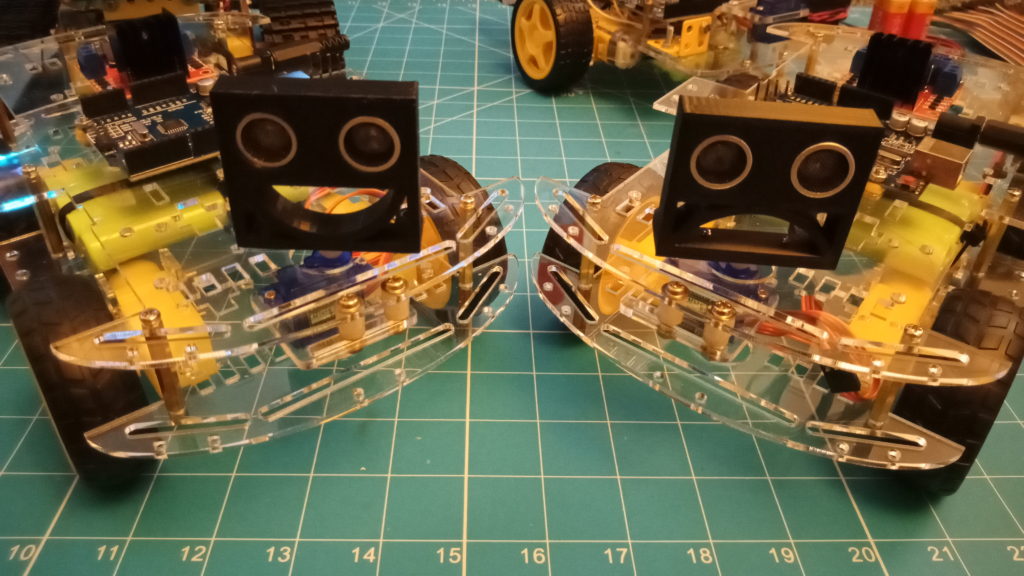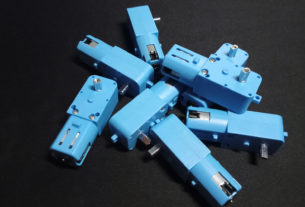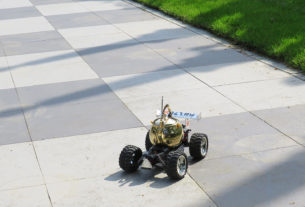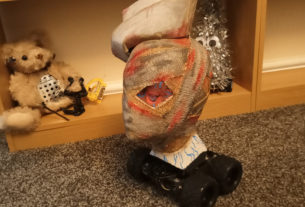We decided a long time ago that when we were building robots, especially just for fun, that we would build them as individually as possible. Different projects, built on different chassis’ (whether we buy them or make them), would allow us to find the robot’s character as it emerges after completion.
Indeed with our A.R.T.I project as a whole, the idea was to make each robot on a different platform. Then, using very similar components we could see how differently each robot turned out once we had engineered our way around the different challenges presented by each chassis.
That was until we were building A.R.T.I 3. and we had already bought a perspex 4WD chassis. It is usually used by people in a low level configuration (motors between the panels), however we intentionally wanted to make them higher so that we could take advantage of the 4WD. The chassis looked like it would break at any moment and has a couple of what we describe as perspex ‘tabs’, holding the motors on poorly, however we reasoned that it was likely to cope with whatever we threw at it.
During our parts ordering session, and in a quest to order diferent cosmetic parts for each robot, I ordered what I thought was a plain black, 3d printed, ultrasonic sensor holder. When it came, that’s almost exactly what it was, however we quickly realised that the holder looked like it had a sad face. A really sad face, nay a mortified face. Discovering our robot character after she was built seemed all but doomed now we had seen her face; It felt like a spoiler.
So when I went and left feedback for it on eBay, giving full marks because it was really well printed, I commented passively that “it was a shame it was a sad face, and that it would ruin our robot.” Thinking we would never hear from the seller, we carried on regardless, positive feedback left with a smidgen of criticism. We carried on building our robot.
A week later however, the post was delivered and a new sensor holder arrived unexpectedly. This time with a happy face. At breakfast I had to explain to my son and daughter about the message I’d left, and proceeded to show them why I now had two similar sensor holders. We then discovered that the seller had responded previously and had redesigned the part to look happier, and then sent it free of charge.
It was such a nice moment. The seller did not have to do anything at all. I had already given full feedback, and accepted the part, but they still went out of their way to try and do something nice.

We decided that the new part would not be a replacement on A.R.T.I 3 (we wouldn’t waste it), but that we would build her some company. We had a morning of brainstorming over breakfast and decided we should build twins. Twin robots. Not easy for a home education family building robots to be purposefully different, we would now have to make two as identical as we could.
Of course, just like real identical twins, there are subtle differences (and not just in the chaos of our wiring). Faces notwithstanding; their front LEDs protrude differently, one of them has a birthmark discolouration on a couple of wheels, A.R.T.I’s 3’s gearboxes are a lighter shade of yellow and their sensors fit differently to one another. Apart from that however, and again ignoring the unpredictability of routing tiny wires, they are wired up identically and they function the same. Exactly the same. They both set off quickly but steadily and they both seem to pile into all but the most obvious obstacles.
Their faces however, the original reason for building a twin pair, do seem to affect how we relate to them. A.R.T.I 3 looks glum and we almost take pity on her. She runs less, and we try and take care of her. She just looks sad, and while there’s nothing inherently wrong with that, it does affect how we see her. A.R.T.I 4 in comparison looks almost gleeful. She looks happier and we find that when needing to test something on either 3 or 4, we invariably reach for her.

It’s an interesting topic that we talk about often. We have not looked at this subject in depth yet, but just from our own interactions and a cursory look at other projects, it may follow that robots in the future may receive a better response from humans if they are friendly, relatable and have that most human quality of all, a beaming smile!
Communication after all in humans is overwhelmingly tipped towards body language and facial expressions.
So the rather suprising, but unexciting story of how we came to build twin robots, led to me being able to teach how relatability to robots in the future is going to be important; aptly demonstrated by two small robots, one grimacing, and one with a huge, beaming smile.
Emma
#RoboticsIsForEveryone



